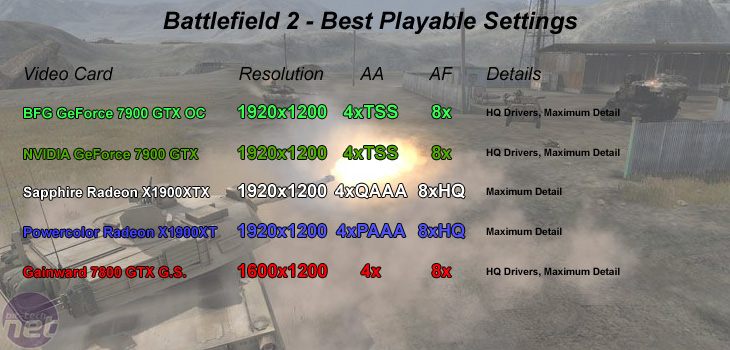Battlefield 2
Publisher: Electronic ArtsBattlefield 2 features an all-new game engine based on the DirectX 9.0 API. There is no Shader Model 3.0 support, but the majority of hardware will use a Shader Model 2.0++ mode that includes support for Normal Maps, Parallax Mapping, Full-Resolution Dynamic Shadowing, Post Processing and Fog.
The game will look the same on both NVIDIA and ATI hardware, so there is no advantage of choosing one over the other in image quality related circumstances. The only major difference is that Ultra Shadow 2 is utilised on NVIDIA's hardware, while the shadowing on ATI hardware is done using a slightly different technique.
We patched the game to version 1.2 and then played three five-minute segments of the 'Strike at Karkand' map, reporting the median frame rate. We found that there was no ready way to duplicate testing situations manually in this game, so we felt that taking a typical slice of action from the game was the best way to report our findings. We controlled Anti-Aliasing from inside the game, while Anisotropic Filtering was set to 8xAF when the 'Texture Filtering' option was set to 'High'.


The Radeon X1900XTX was able to play the game at the same resolution as the two GeForce 7900 GTX frequencies that we've tested here. We found that Battlefield 2 was playable at 1920x1200 4xQAAA 8xHQ AF with all details set to their maximum. High quality anisotropic filtering made a huge difference in this title. Even with high quality driver settings, there were still some quite large differences in texture filtering quality - this was most noticeable on gravel or grass-textured areas.
PowerColor's X1900XT was a little slower than the Radeon X1900XTX, such that we felt the frame rate was dropping too low to fully appreciate the BF2 experience at 1920x1200 4xQAAA 8xHQ AF. With quality adaptive AA, the minimum frame rate was 33 fps - we feel that's too low for a large multiplayer server. The gaming experience was much smoother after we lowered the adaptive antialiasing detail from quality to performance. As a result, the minimum frame rate increased to well over 40 fps.

MSI MPG Velox 100R Chassis Review
October 14 2021 | 15:04







Want to comment? Please log in.